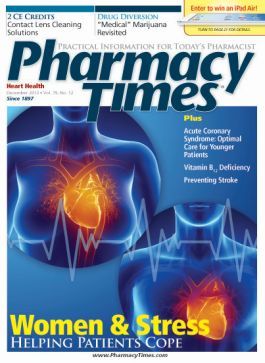Publication
Article
Pharmacy Times
Selection of Blood Pressure Monitors: An Essential Tool for At-Home Monitoring
Author(s):
Helping patients select an appropriate blood pressure monitor and ensuring that they are comfortable using it are crucial for heart health.
Helping patients select an appropriate blood pressure monitor and ensuring that they are comfortable using it are crucial for heart health.
One of the most valuable tools that an individual with hypertension can employ to control his or her blood pressure (BP) is a reliable at-home BP monitor.
Pharmacists are likely to encounter patients seeking guidance regarding the selection of BP monitors. Pharmacists can assist patients in selecting a monitor that best suits individual needs and can ensure that patients are properly educated and comfortable using the device. Hypertension can be effectively managed and controlled with early intervention; adherence to therapy, including dietary and pharmacologic therapy, if needed; and routine BP monitoring.
The American Heart Association (AHA) recommends routine at-home monitoring for all patients with hypertension.1 At-home BP monitoring is considered to be especially beneficial for the following patient populations1,2:
- Patients initiating therapy with antihypertensive agents to determine effectiveness of therapy
- Patients requiring closer monitoring than provided by intermittent physician office visits (ie, patients with coronary heart disease, diabetes, and/ or renal disease)
- Patients who have some elevated BP readings at the physician’s office, to rule out “white coat syndrome” and confirm true high BP
- Pregnant women, because preeclampsia or pregnancy-induced hypertension can develop rapidly
- Elderly patients, because the white coat effect increases progressively with age
- Patients suspected of having masked hypertension
Hypertension Risk Factors
Certain risk factors, which can be categorized as modifiable or nonmodifiable, may augment an individual’s risk for developing hypertension. Patients with a history of hypertension or those at risk for hypertension should be encouraged to discuss their risk factors and BP levels with their primary health care provider. Individuals with BP higher than 140/90 mm Hg are at greater risk for serious cardiovascular disease, such as stroke, myocardial infarction, and congestive heart failure (Table 11-6; Table 22,9).7,8
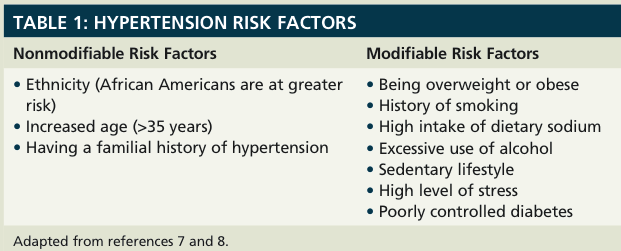
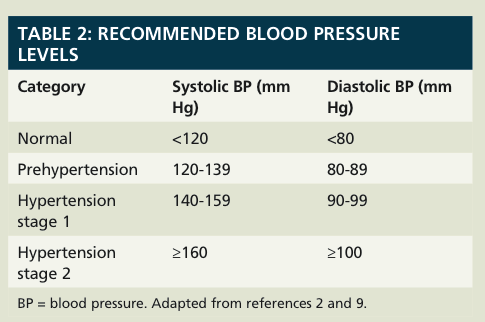
Types of At-Home BP Monitors
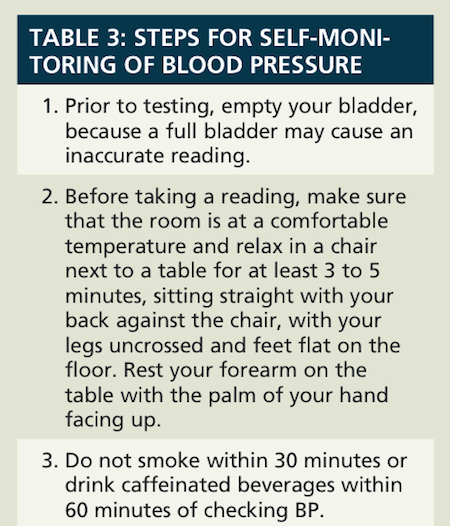
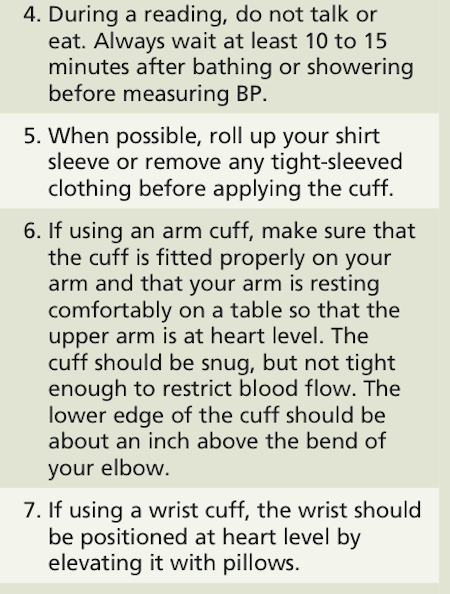
Aneroid and digital monitors are commonly used for at-home BP monitoring.2,10 Factors to consider when selecting a monitor may include cost, cuff size, ease of use, patient preference, memory features, large digital display, reliability, and accuracy.
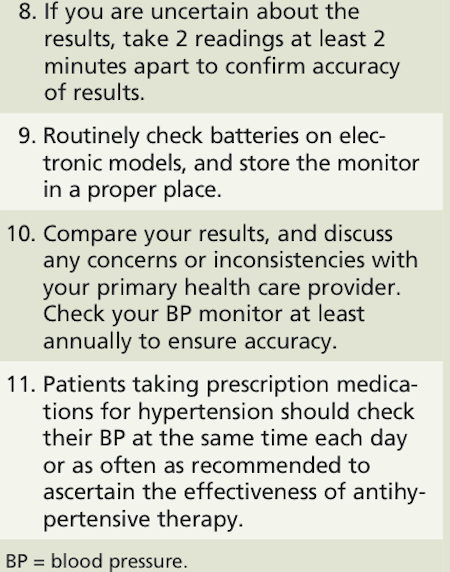

2,10
Some monitors have self-inflating and -deflating cuffs, but manual BP monitors are still available. Many monitors can store several readings, have large display screens for easy reading, allow printing of results, and can detect irregular heartbeats as well as pressure rating. When recommending an arm-type monitor, pharmacists should stress the importance of selecting one with the proper cuff size to obtain accurate results.2,10
Aneroid monitors are light, portable, and considered to be reasonably priced.2 It is imperative that patients be educated on the use of these monitors and clearly understand the testing procedure to obtain accurate results.2,10 Many aneroid monitors come with a stethoscope attached to the cuff, which frees the patient from having to hold the bell of the stethoscope in place.2,10 Some monitors also have the gauge attached to the inflation bulb, which allows for easier handling.2 The accuracy of readings with standard aneroid monitors depends on various factors such as good eyesight, hearing, and dexterity.2 For patients with decreased vision, there are aneroid meters with large-print displays on the gauge for easier reading.2
Patients electing to use aneroid meters should be informed that when the cuff is completely deflated and lying on a table, the needle of the gauge should rest in the box. If the needle lies outside the box, the gauge will need to be recalibrated. For instructions on recalibration, patients should contact the device’s manufacturer or their primary health care provider.2,10
Digital monitors are typically the most popular type of BP monitor because they are easy to use. While they are available for the upper arm or the wrist, the AHA currently recommends the use of automatic cuff-style upper-arm monitors and does not recommend wrist monitors because the brachial artery in the upper arm gives a more reliable reading than the wrist artery.2,10 While wrist monitors are compact and portable, some studies suggest that wrist monitors are not as accurate as upper-arm monitors and that errors may occur due to differences in the positioning of the wrist relative to the heart during measurement.2,10
Table 3 lists the steps for self-monitoring of blood pressure.
Closing Thoughts
When assisting patients in the selection of BP monitors, pharmacists should always stress the importance of regularly monitoring BP to ensure that prescribed therapy is effective or to ascertain whether therapy changes are warranted. During counseling, patients should also be reminded about the serious consequences associated with uncontrolled BP and the critical nature of adhering to their therapy, possibly including weight loss, reduced salt intake, smoking cessation, and regular exercising, when warranted. In addition, patients should be encouraged to discuss any concerns about their BP with their primary health care provider.
Patient Resources for Hypertension
• Hypertension Education Foundation: www.hypertensionfoundation.org/booklets.cfm
• American Society of Hypertension: www.ash-us.org/For-Patients/Patient-Education-Information.aspx
Ms. Terrie is a clinical pharmacy writer based in Haymarket, Virginia.
References
- Middle-age blood pressure changes affect lifetime heart disease, stroke risk. American Heart Association website. http://newsroom.heart.org. Accessed October 30, 2013.
- Briggs G, Hurley H. Home testing and monitoring devices. In: Krinsky D, Berardi R, Ferreri S, et al, eds. Handbook of Nonprescription Drugs. 17th ed. Washington, DC: American Pharmacists Association; 2012.
- Hypertension. National Institutes of Health website. http://report.nih.gov/nihfactsheets/ViewFactSheet.aspx?csid=97. Accessed October 30, 2013.
- 2013 High Blood Pressure Statistics. American Heart Association website. https://www.heart.org. Accessed October 28, 2013.
- High blood pressure facts. Centers for Disease Control and Prevention website. www.cdc.gov/bloodpressure/facts.htm. Accessed October 29, 2013.
- Quick Facts on hypertension and high blood pressure. World Heart Foundation website. www.world-heart-federation.org/press/fact-sheets/cardiovascular-disease-risk-factors/quick-facts-on-hypertension-high-blood-pressure. Accessed October 29, 2013.
- Risk factors (high blood pressure). Centers for Disease Control and Prevention website. www.cdc.gov/bloodpressure/risk_factors.htm. Accessed October 29, 2013.
- Understand your risk for high blood pressure. American Heart Association website. www.heart.org/HEARTORG/Conditions/HighBloodPressure/UnderstandYourRiskforHighBloodPressure/Understand-Your-Risk-for-High-Blood-Pressure_UCM_002052_Article.jsp. Accessed October 29, 2013.
- Understanding blood pressure readings. American Heart Association website. www.heart.org/HEARTORG/Conditions/HighBloodPressure/AboutHighBloodPressure/Understanding-Blood-Pressure-Readings_UCM_301764_Article.jsp. Accessed October 29, 2013.
- Choosing a blood pressure monitor. American Heart Association website. www.heart.org/HEARTORG/Conditions/HighBloodPressure/SymptomsDiagnosisMonitoringofHighBloodPressure/Choosing-a-Home-Blood-Pressure-Monitor_UCM_303322_Article.jsp. Accessed October 30, 2013.
- Blood pressure measurement. Medline Plus website. www.nlm.nih.gov/medlineplus/ency/article/007490.htm. Accessed October 2, 2013.
- Tips for having your blood pressure taken. National Heart, Lung and Blood Institute website. www.nhlbi.nih.gov/hbp/detect/tips.htm. Accessed October 29, 2013.
Newsletter
Stay informed on drug updates, treatment guidelines, and pharmacy practice trends—subscribe to Pharmacy Times for weekly clinical insights.

